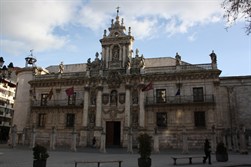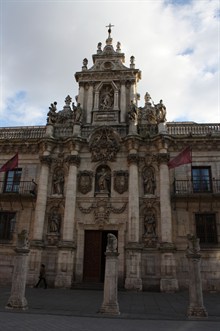The University
 The University of Valladolid is one of the oldest in the Iberian Peninsula. Some hypotheses can be ventured as to its origin. It possibly arose from the transfer to the city of the Estudio General from PalenciaNow belonging to the current Comunidad Autónoma de Castilla y León, Palencia had its heyday in the Middle Ages. Already a bishopric under the Visigoths, the city was home to the oldest Spanish university, approved by Pope Honorius III in 1221 but disappeared after a few decades. In the Early modern Age it shared the fate of Castile: as the centre of the empire of Charles V and the monarchy of Philip II, it also underwent a severe crisis during the seventeenth century., considered the first university in the history of Spain, or it was instead created directly in Valladolid by the Castilian kings and by the Council of the City. Certainly, the University was already active in the last quarter of the thirteenth century, enjoying royal protection and, later, even that of the pope. With the passing of centuries, the university grew in importance and wealth, thanks to the economic yields guaranteed by the Kings of Castile. In the sixteenth century the University of Valladolid was declared, together with those of Salamanca and Alcalá, one of the three Universidades Mayores of the kingdom, that forged the bureaucratic, administrative and judicial staff of the system that would sustain the Habsburg monarchy. In this regard the importance of the faculty of Law grew, but so did that of the faculty of Medicine. During the seventeenth and eighteenth centuries, the general crisis that struck Castile also affected the world of culture and higher education, with a reduction in the number of students, the intellectual level and also the economic resources of the university.
The University of Valladolid is one of the oldest in the Iberian Peninsula. Some hypotheses can be ventured as to its origin. It possibly arose from the transfer to the city of the Estudio General from PalenciaNow belonging to the current Comunidad Autónoma de Castilla y León, Palencia had its heyday in the Middle Ages. Already a bishopric under the Visigoths, the city was home to the oldest Spanish university, approved by Pope Honorius III in 1221 but disappeared after a few decades. In the Early modern Age it shared the fate of Castile: as the centre of the empire of Charles V and the monarchy of Philip II, it also underwent a severe crisis during the seventeenth century., considered the first university in the history of Spain, or it was instead created directly in Valladolid by the Castilian kings and by the Council of the City. Certainly, the University was already active in the last quarter of the thirteenth century, enjoying royal protection and, later, even that of the pope. With the passing of centuries, the university grew in importance and wealth, thanks to the economic yields guaranteed by the Kings of Castile. In the sixteenth century the University of Valladolid was declared, together with those of Salamanca and Alcalá, one of the three Universidades Mayores of the kingdom, that forged the bureaucratic, administrative and judicial staff of the system that would sustain the Habsburg monarchy. In this regard the importance of the faculty of Law grew, but so did that of the faculty of Medicine. During the seventeenth and eighteenth centuries, the general crisis that struck Castile also affected the world of culture and higher education, with a reduction in the number of students, the intellectual level and also the economic resources of the university.
 During this long period of crisis one of the finest examples of the Baroque in Valladolid was built. The façade of the historic building of the University, the current Law school, was in fact built between 1716 and 1718 under the direction of the Discalced Carmelite Fathers of the local convent and the second project was presented by fray Pedro de la Visitación. It is the only surviving part of the ancient building, which was demolished in the early twentieth century. It had been built both to meet the increased demands of space by the University and to turn it into one of the most important and significant places of the city (Plaza de Santa María, today Plaza de la Universidad). The numerous statues and ornamental sculptures are the work of the ToméAntonio, Narciso and Diego Tomé were members of a family of Castilians sculptors, best known for their work on the façade of the University of Valladolid. The most important of the three was definitely Narciso (1690-1742), who worked alongside Churriguera and was the maestro mayor of the cathedral of Toledo, at which he worked with his sons in the latter part of his life., Antonio and his sons Narciso and Diego. The main façade, divided by four giant columns, presents the disciplines that were taught there: Theology in the centre, surrounded by Rhetoric, Geometry, Civil and Canon Law; higher up, on top of the four columns, one can observe Astrology, Medicine, Philosophy and History, while above them dominates the personification of Wisdom, intent on crushing ignorance. On the balustrade, four statues remind rulers of the efforts they had to make for the University of Valladolid: Alfonso VIIIAlfonso VIII of Castile (1155-1214) was King of Castile from the age of three until his death. He is best remembered for the great victory at the Battle of Las Navas de Tolosa (July 16, 1212) against the Muslim troops, decisive for the gradual Reconquista of the Iberian Peninsula., John IJohn I of Castile (1358-1390) was King of Castile from 1379 until his death. The son of Henry II of Castile, he was born in Aragon during the exile of his father, who at the time was not yet king., Henry IIIHenry III of Castile (1379-1406), known as el Doliente (the suffering), was King of Castile after the death of his father John I, in 1390, until 1406 and was succeeded by his son, John II of Castile. and Philip II. The symbol of the Estudio is placed at the centre, above the statue of Theology, while the spacious foyer, defined by eighteen columns decorated with as many lions which support the royal coat of arms, further strengthens the grand appearance of the entire façade.
During this long period of crisis one of the finest examples of the Baroque in Valladolid was built. The façade of the historic building of the University, the current Law school, was in fact built between 1716 and 1718 under the direction of the Discalced Carmelite Fathers of the local convent and the second project was presented by fray Pedro de la Visitación. It is the only surviving part of the ancient building, which was demolished in the early twentieth century. It had been built both to meet the increased demands of space by the University and to turn it into one of the most important and significant places of the city (Plaza de Santa María, today Plaza de la Universidad). The numerous statues and ornamental sculptures are the work of the ToméAntonio, Narciso and Diego Tomé were members of a family of Castilians sculptors, best known for their work on the façade of the University of Valladolid. The most important of the three was definitely Narciso (1690-1742), who worked alongside Churriguera and was the maestro mayor of the cathedral of Toledo, at which he worked with his sons in the latter part of his life., Antonio and his sons Narciso and Diego. The main façade, divided by four giant columns, presents the disciplines that were taught there: Theology in the centre, surrounded by Rhetoric, Geometry, Civil and Canon Law; higher up, on top of the four columns, one can observe Astrology, Medicine, Philosophy and History, while above them dominates the personification of Wisdom, intent on crushing ignorance. On the balustrade, four statues remind rulers of the efforts they had to make for the University of Valladolid: Alfonso VIIIAlfonso VIII of Castile (1155-1214) was King of Castile from the age of three until his death. He is best remembered for the great victory at the Battle of Las Navas de Tolosa (July 16, 1212) against the Muslim troops, decisive for the gradual Reconquista of the Iberian Peninsula., John IJohn I of Castile (1358-1390) was King of Castile from 1379 until his death. The son of Henry II of Castile, he was born in Aragon during the exile of his father, who at the time was not yet king., Henry IIIHenry III of Castile (1379-1406), known as el Doliente (the suffering), was King of Castile after the death of his father John I, in 1390, until 1406 and was succeeded by his son, John II of Castile. and Philip II. The symbol of the Estudio is placed at the centre, above the statue of Theology, while the spacious foyer, defined by eighteen columns decorated with as many lions which support the royal coat of arms, further strengthens the grand appearance of the entire façade.
